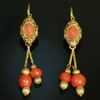Nu gespreide betaling mogelijk op het juweel van uw dromen! Vraag ons naar de details. Gratis verzekerde verzending van alle orders!
Earring

See our: antique earrings.
An ear ornament, worn suspended from a bent wire or thin hoop passed through a hole pierced in the lobe of the ear, in later years, clipped or screwed to the lobe (called an ear-clip or ear-screw).
Earrings, worn from earliest times, have been made of gold, silver, platinum, silver gift, etc., and in a great variety of shapes, styles, and sizes, and with various ornamentation and pendants made of a variety of materials, e.g. gold, coral, jade, jet, glass, etc.
Hellenistic examples were often decorated with the head of an animal, siren, etc. Later Greek, Roman, and Etruscan examples were often made as a hook with a pendant that was shaped like a crescent, boat, or figure, or with a rosette or disc masking the hook, or in the form of a penannular ring having one end decorated with a human or animal head.
Some Anglo-Saxon examples are set with a garnet or red glass. During the Renaissance, the style of shorter hair led to a revival of the wearing of ear-rings, not only by women but also, in Spain and England, by men (sometimes wearing only one); the decoration was more elaborate and often included pendent pearls.
Thereafter earrings have continued to be worn, often set with gemstones, the styles reflecting the prevalent styles of the times. The French term is boucle d'oreille.
From: An Illustrated Dictionary of Jewelry, autor: Harold Newman, publishers: Thames and Hudson









